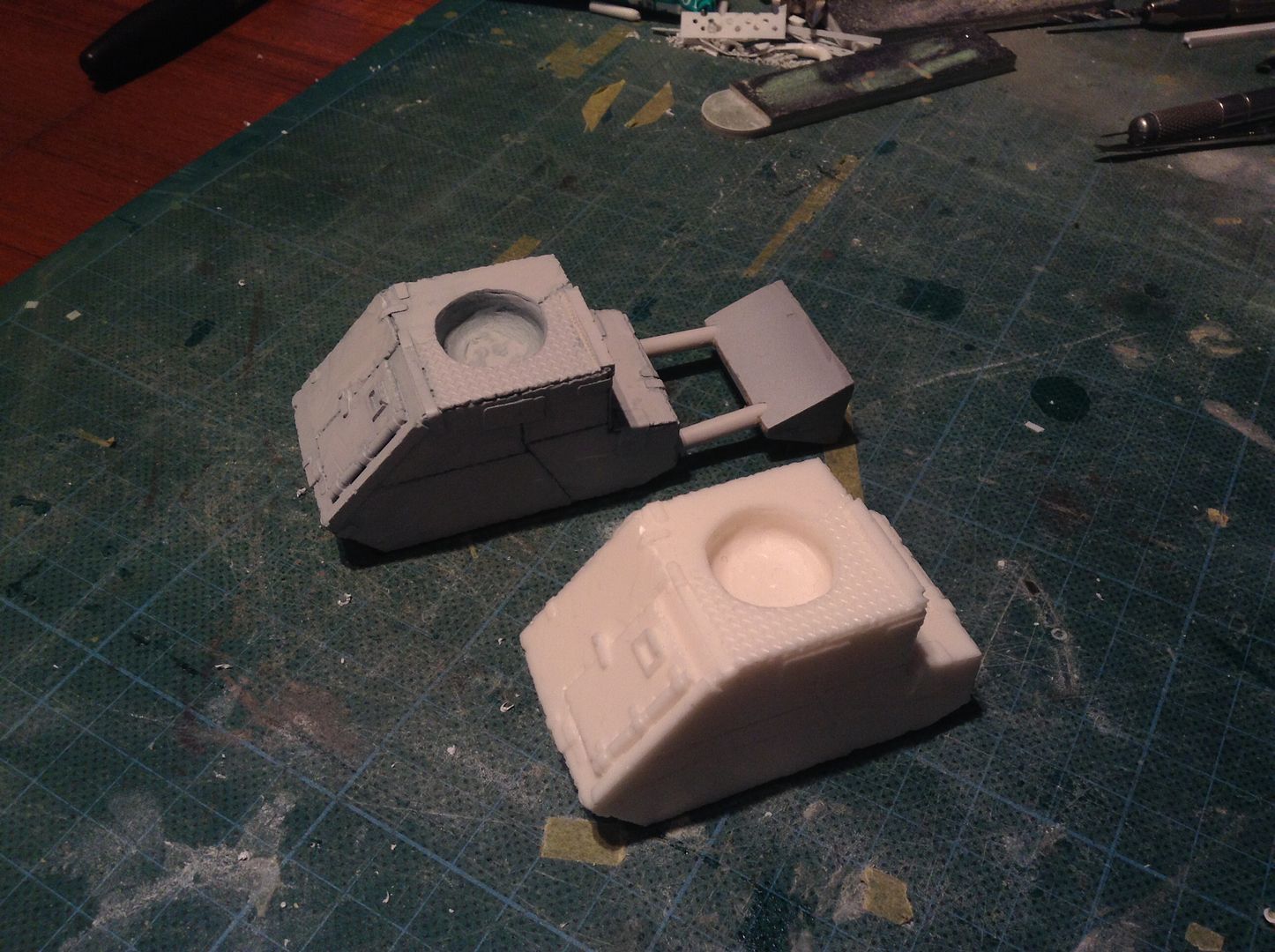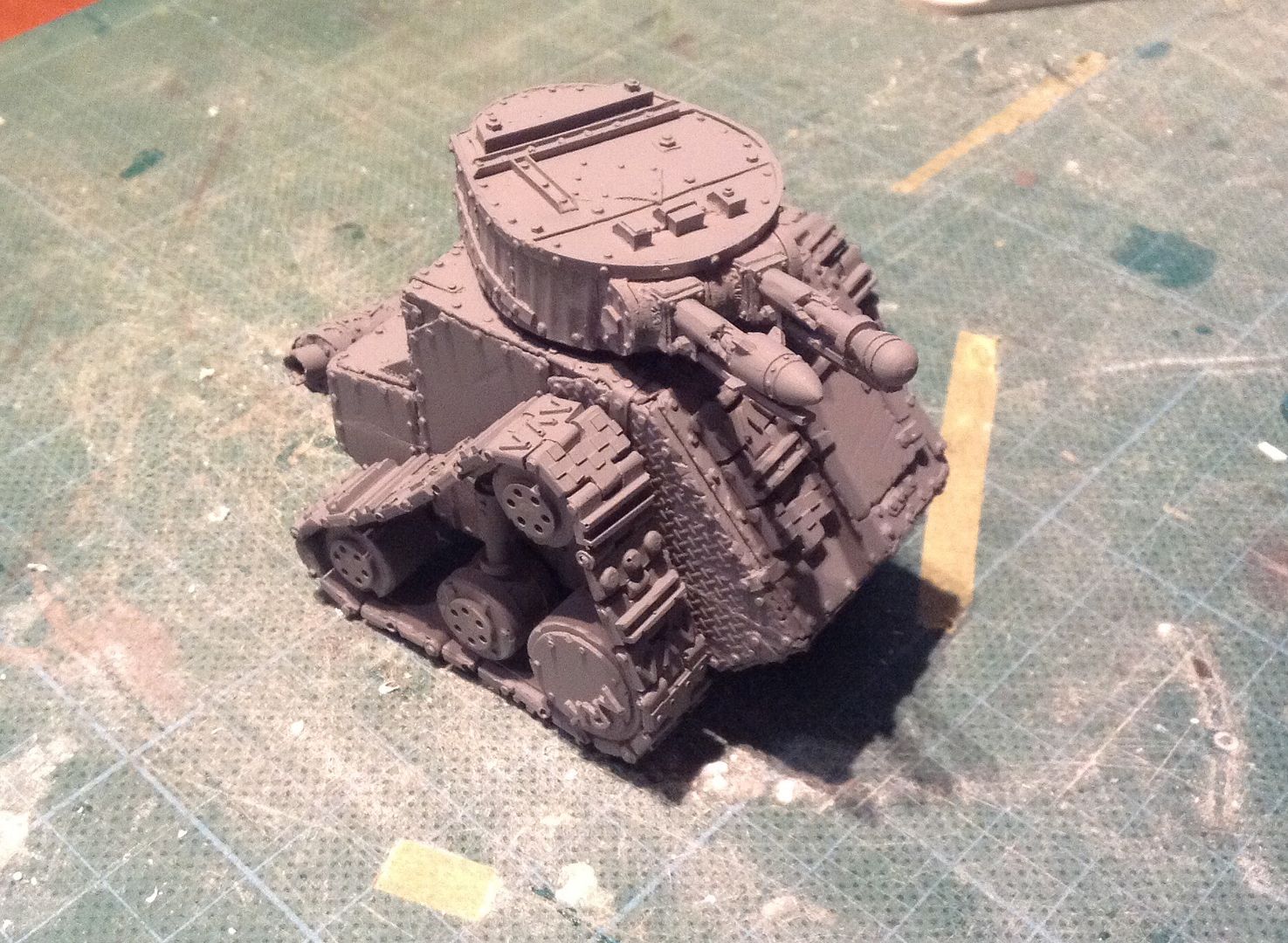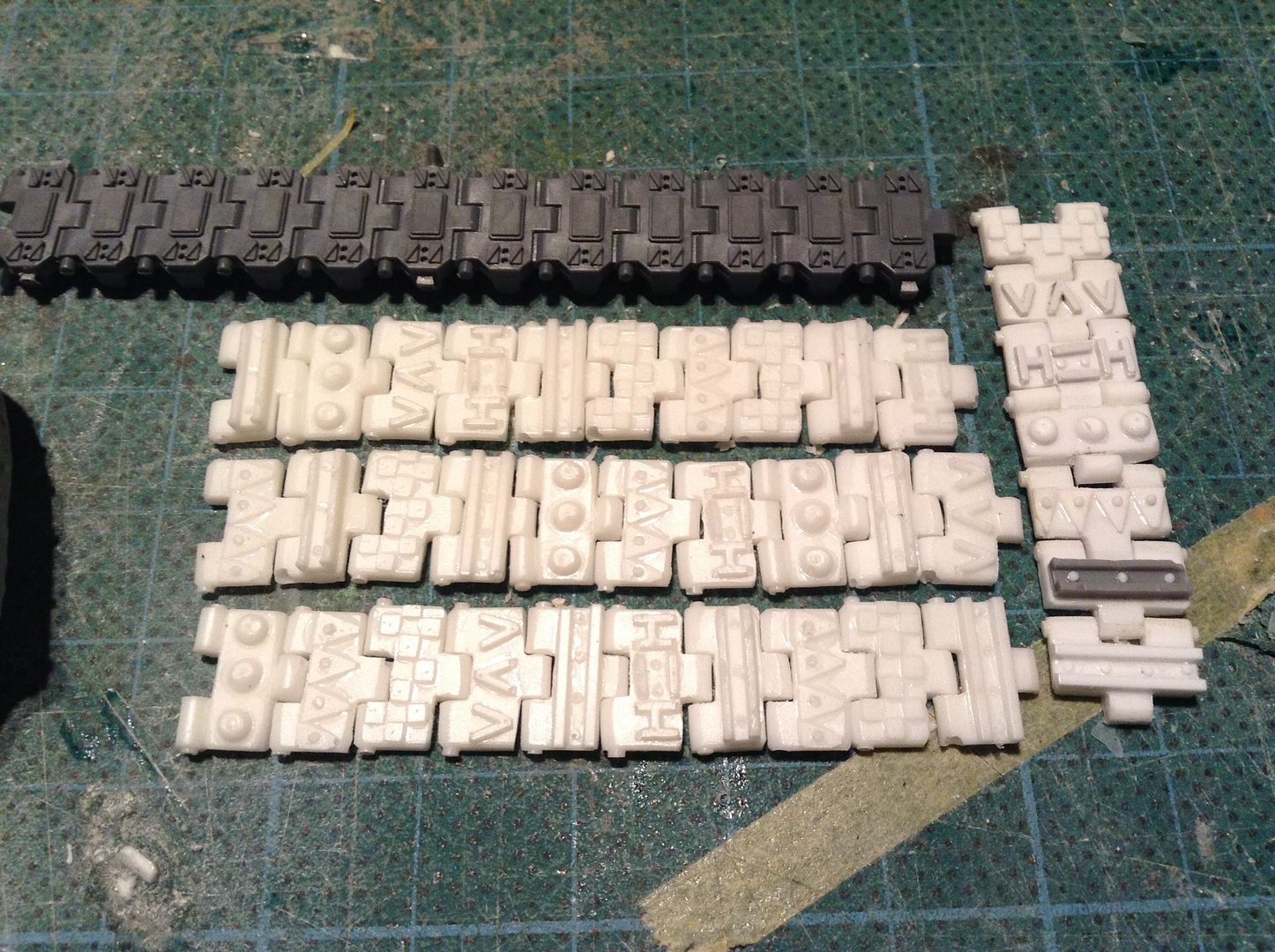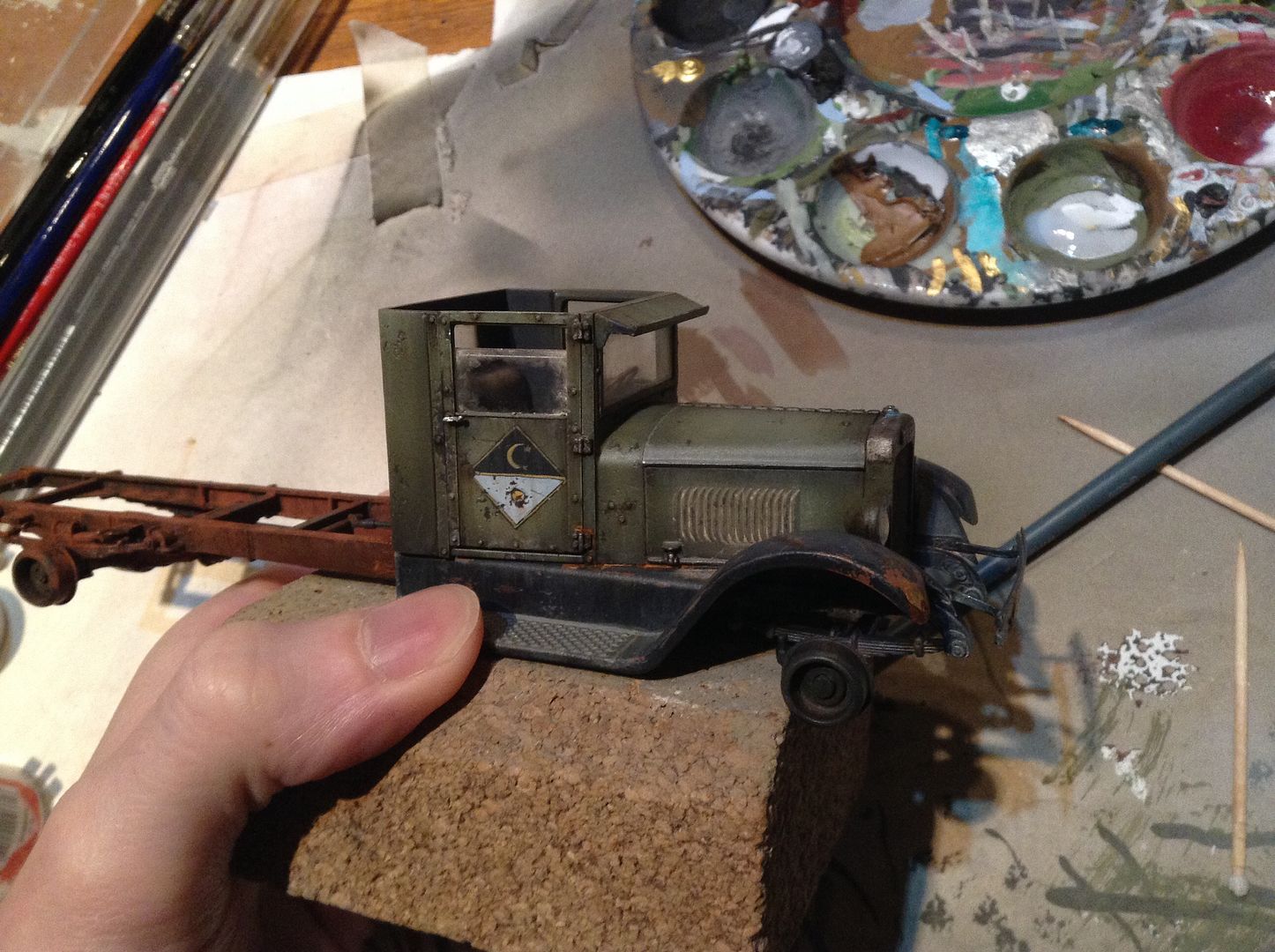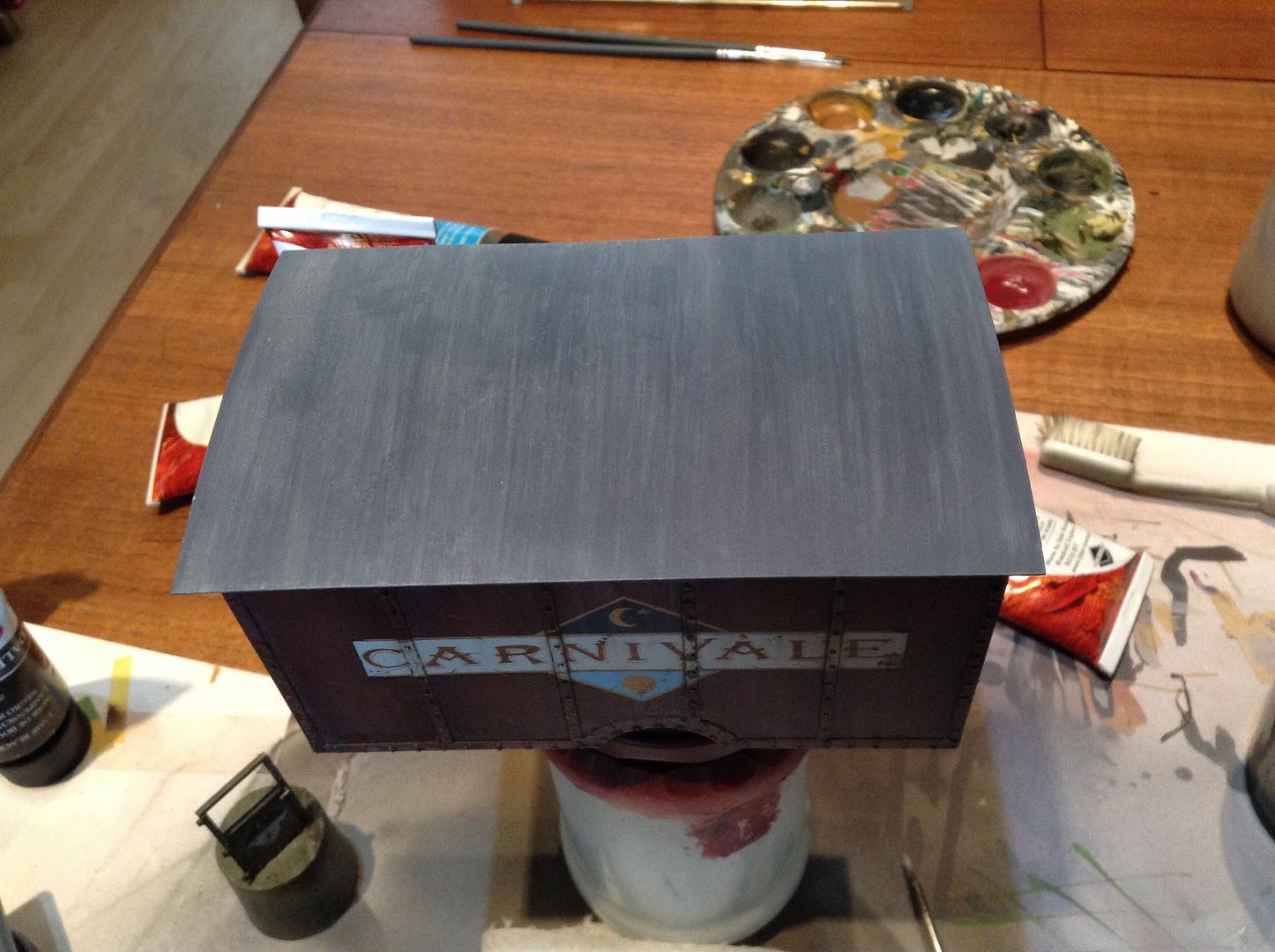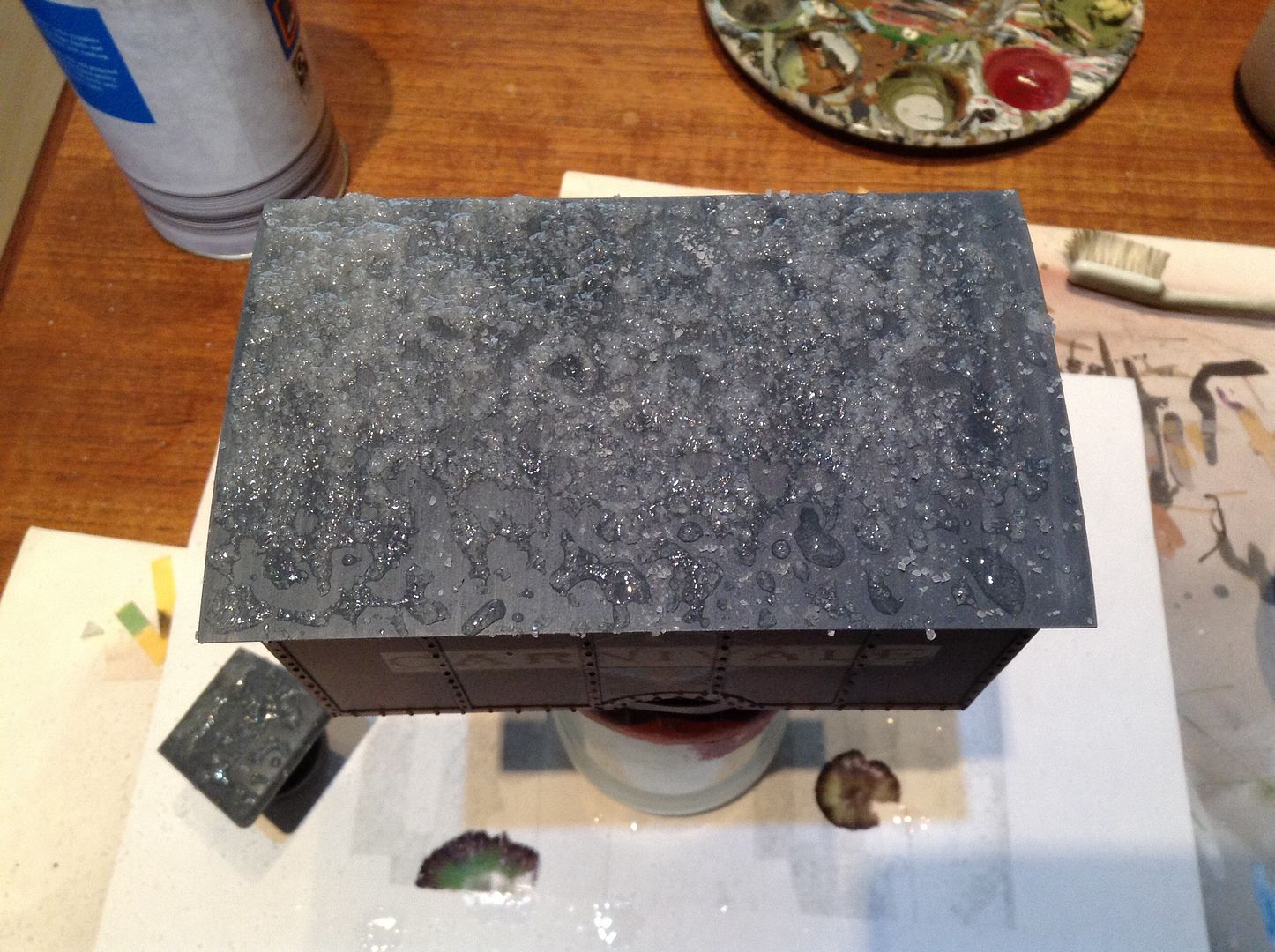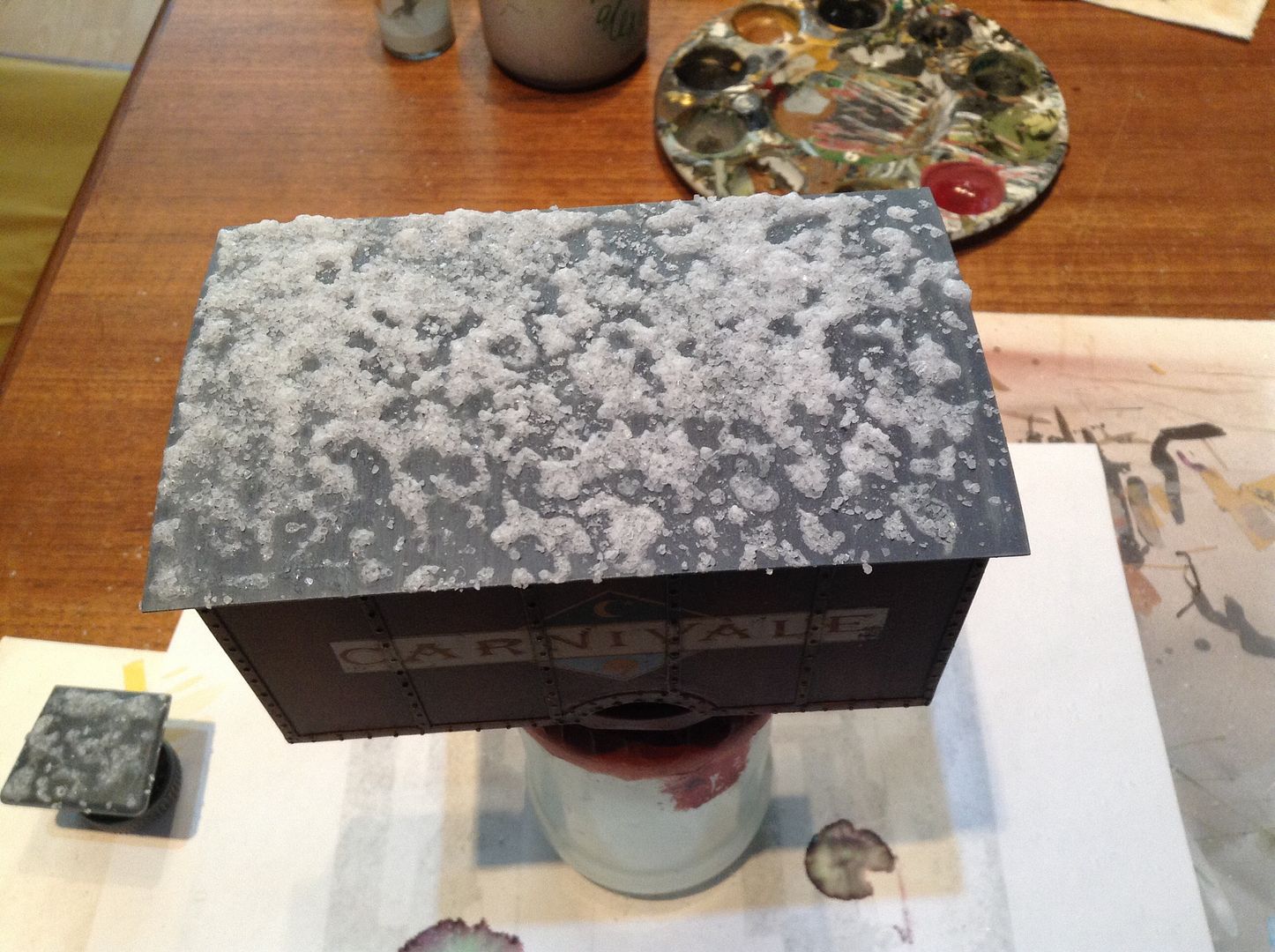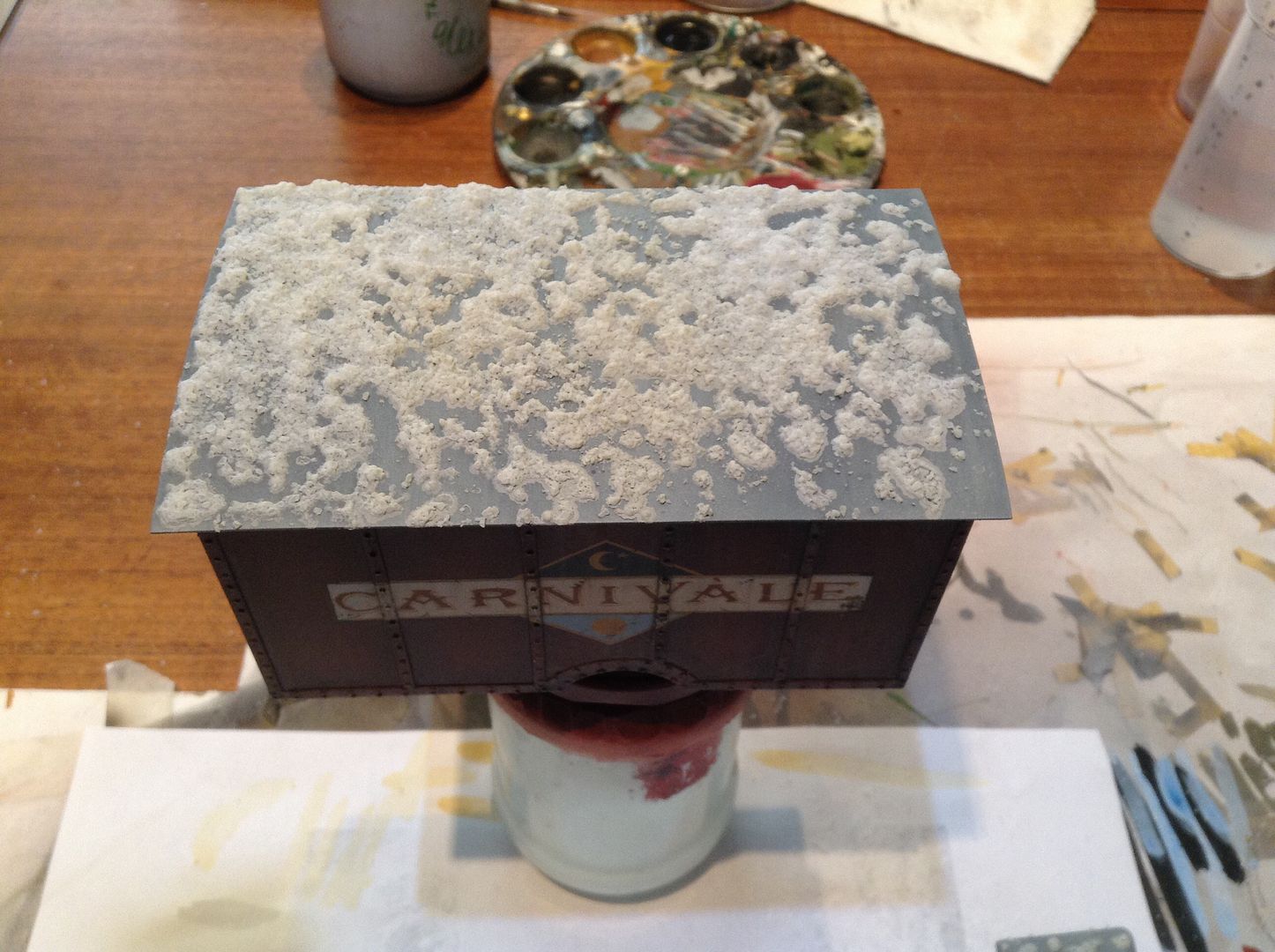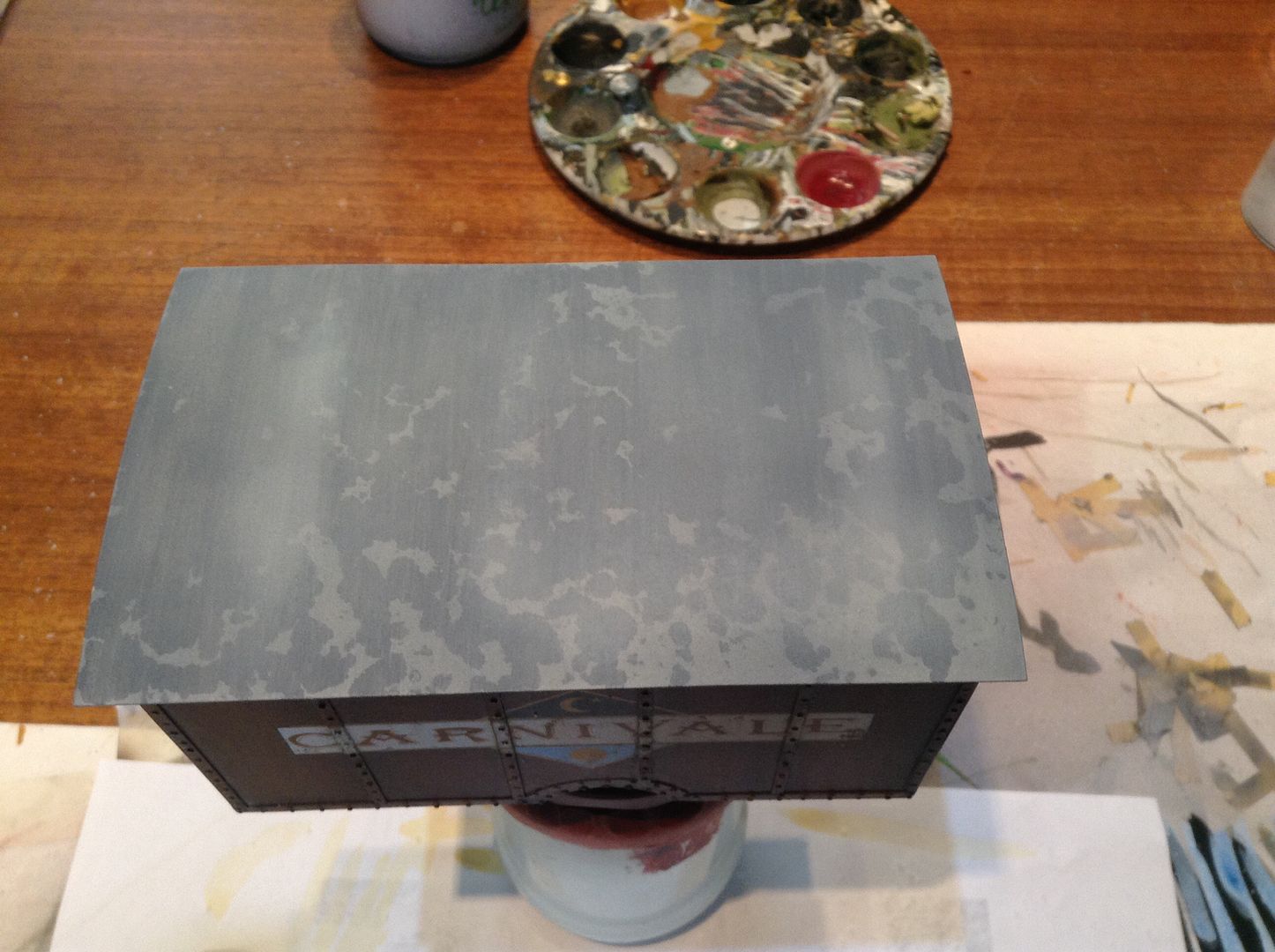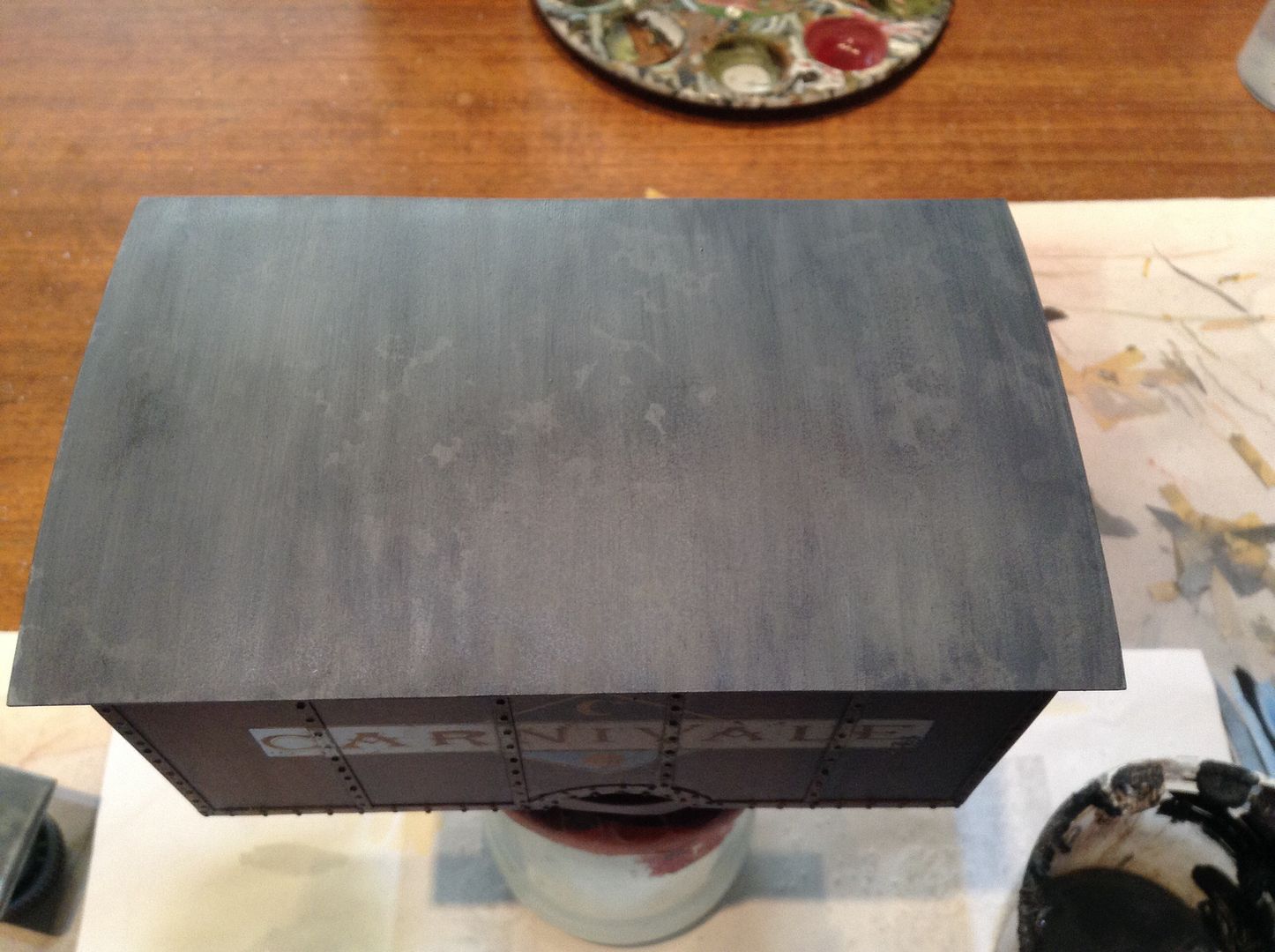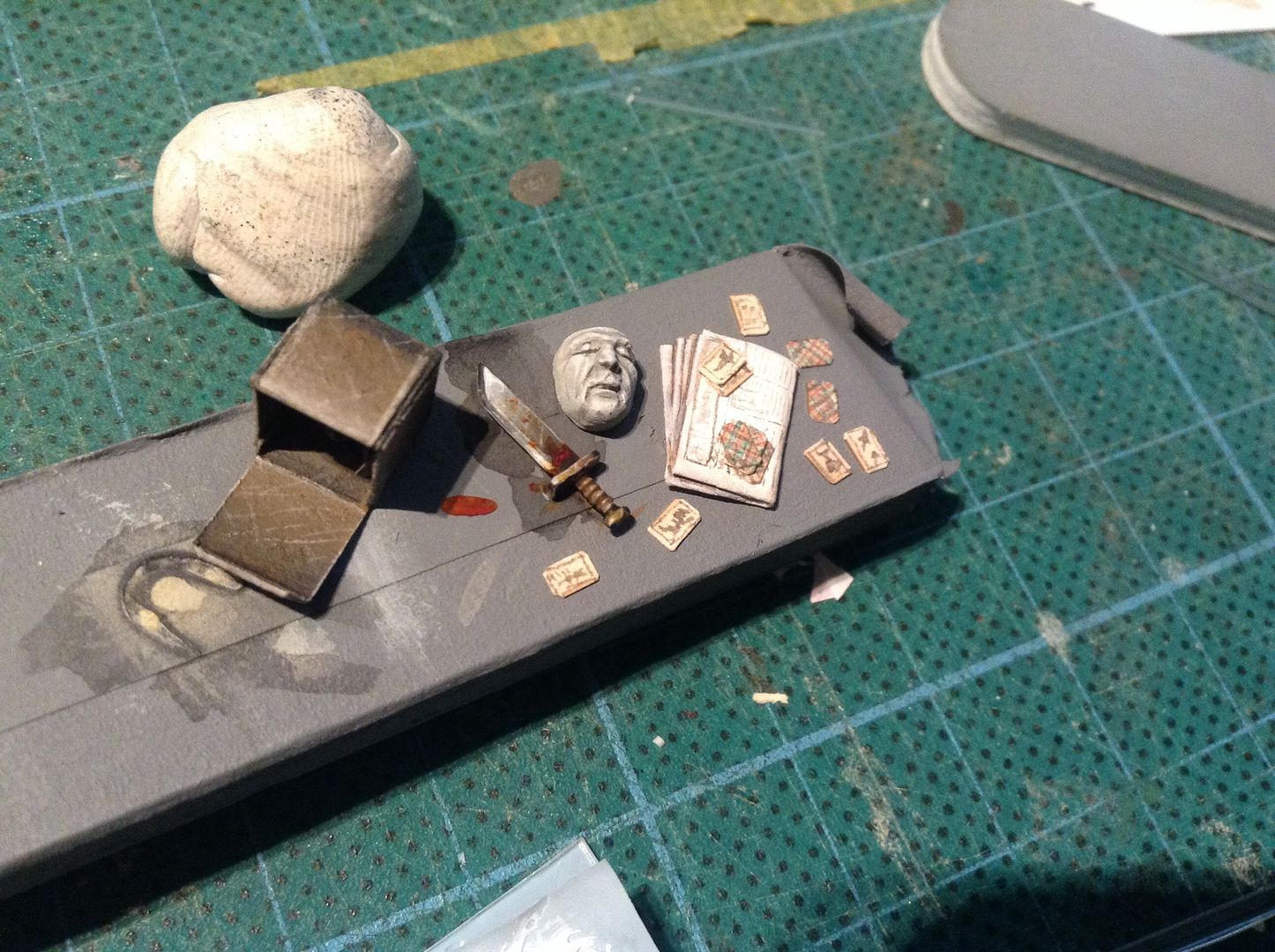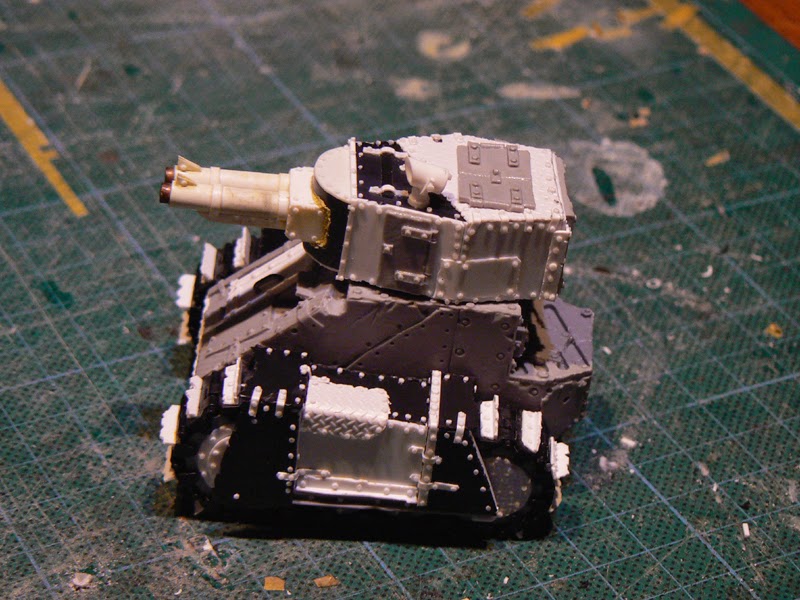After a mammoth session casting up track links, it was time to try putting one of my new Scrot Tanks (grot tanks) together. I haven't shown you the chassis yet, mostly because it really doesn't photograph well in either it's plasticard master or resin cast form, but here goes.
As you can see, I added a casting gate to the master and a couple of flow channels to assist with the casting process: essentially, the casting gate is where you tip the resin in, the bulk of it helps to add a little pressure which in theory forces the resin into all the little details of the mould, but with it being such a small mould I'm not certain it really helps much. The one channel is there to let the resin into the mould, the other lets the air out of the mould, it also lets you know when the mould is full.
So, leap forward a few days and I have a fully assembled Scrot Tank, ready for a lick of paint or two.
As always, the photos aren't great, daylight here in the UK is at a minimum at the moment, and I wasn't really up for getting the light tent set up, so I apologise for the poor image quality of this post. It's worth pointing out that I didn't apply the rivets to the master model of the chassis, I was pretty confident that my moulding and casting skills/equipment wouldn't replicate them well enough. So rather than having to remove botched ones and replace them, I just applied them to the cast instead. There are quite a few little air bubbles in the treads, but they'll eventually be covered up by weathering and mud, so I'm not too worried about them right now. The same goes for the unsightly mould-line along the lower side of the chassis, some carefully applied mud spatter should cover that little issue.
Friday, 19 December 2014
Tuesday, 2 December 2014
The Scrots of The Terra Damnata 2: More Scrot Tanks!
Rumours of my death haven't been greatly exaggerated, mainly because I haven't heard any rumours of my death. Although the blog has been quiet, I have been making progress behind the scenes.
A while ago, I managed to snag myself three Forge World grot tank turrets from eBay for a bargain price, which put me in the unfortunate situation of having two grotzooka turrets and a twin-linked rokkit launcha turret and nothing to mount them on. My first thought was to order another four grot tanks from Forge World, but this would still leave me with the wrong numbers in my turret to tank ratio (however, it would give me another four of the awesome little buggers to play with), after a while I decided to scratchbuild the rest of the tanks to give me something usable. Remembering that I had a batch of polyurethane resin and silicone slowly expiring in my shed and a degree partially in mould making and casting (although, this degree was attained over ten years ago now, and I haven't really practised my skills between now and then) I decided to mould and cast as much of the tanks as I could.
A few weeks of slowly building the masters for the tank chassis and the treads, mould making and casting, and I nearly have enough bits to cobble together the first tank. To give you a little peak at the progress so far, here's a shot of some treads, fresh out of the mould and uncleaned- next to some Games Workshop treads for scale, and the original sculpts.
The resin itself is a pretty unphotogenic off-white, but hopefully you can make out the details (and bubbles) well enough. Each tread is a separate cast and there are seven different ones, which should be enough to not get too repetitive. By my best guess, I'll probably need 70 treads per tank, so I need to double what you see above, but that shouldn't cause any problems really.
Anyway, back to the casting and scratchbuilding- some sort of bogie mount is next in line I think.
A while ago, I managed to snag myself three Forge World grot tank turrets from eBay for a bargain price, which put me in the unfortunate situation of having two grotzooka turrets and a twin-linked rokkit launcha turret and nothing to mount them on. My first thought was to order another four grot tanks from Forge World, but this would still leave me with the wrong numbers in my turret to tank ratio (however, it would give me another four of the awesome little buggers to play with), after a while I decided to scratchbuild the rest of the tanks to give me something usable. Remembering that I had a batch of polyurethane resin and silicone slowly expiring in my shed and a degree partially in mould making and casting (although, this degree was attained over ten years ago now, and I haven't really practised my skills between now and then) I decided to mould and cast as much of the tanks as I could.
A few weeks of slowly building the masters for the tank chassis and the treads, mould making and casting, and I nearly have enough bits to cobble together the first tank. To give you a little peak at the progress so far, here's a shot of some treads, fresh out of the mould and uncleaned- next to some Games Workshop treads for scale, and the original sculpts.
The resin itself is a pretty unphotogenic off-white, but hopefully you can make out the details (and bubbles) well enough. Each tread is a separate cast and there are seven different ones, which should be enough to not get too repetitive. By my best guess, I'll probably need 70 treads per tank, so I need to double what you see above, but that shouldn't cause any problems really.
Anyway, back to the casting and scratchbuilding- some sort of bogie mount is next in line I think.
Thursday, 16 October 2014
Carnivàle Truck 7
The Carnivàle Truck is very nearly finished now, when I get to this stage in a project I like to get a few photos of the model so I can see better what needs improving. For some reason, when you see the model on a screen you start to notice imperfections that you can't really pick up when looking at the model, the magnification helps too.
The weathering is mostly done with oil paints, either as pin-washes applied to the crevices and rivets, or applied neat and then blended in with white spirits in specific areas. The dusty areas again are mostly off-white oil paints, except on the windows which are AK Interactive pigments applied in a wash with water, then cleaned away with water. The windows deserve a mention, after reshaping the window frames quite significantly, the supplied panes wouldn't fit (and were way too thick anyway) so I cut some new ones from clear blister-pack plastic. Its not really that clear in these photos, but I scribed a line about 1mm in from all the edges on the inside of each pane to replicate a detail on the screen used vehicle.
An important lesson I've learned here is that the detritus I put inside the truck cab is entirely a waste of time. You can't see it on the real model, and you can't see it in the photos. It was fun to make though.
Right, on to the final touch-ups and then some proper photos of the finished truck.
The weathering is mostly done with oil paints, either as pin-washes applied to the crevices and rivets, or applied neat and then blended in with white spirits in specific areas. The dusty areas again are mostly off-white oil paints, except on the windows which are AK Interactive pigments applied in a wash with water, then cleaned away with water. The windows deserve a mention, after reshaping the window frames quite significantly, the supplied panes wouldn't fit (and were way too thick anyway) so I cut some new ones from clear blister-pack plastic. Its not really that clear in these photos, but I scribed a line about 1mm in from all the edges on the inside of each pane to replicate a detail on the screen used vehicle.
An important lesson I've learned here is that the detritus I put inside the truck cab is entirely a waste of time. You can't see it on the real model, and you can't see it in the photos. It was fun to make though.
Right, on to the final touch-ups and then some proper photos of the finished truck.
Labels:
carnivale,
Gaz-AA,
historical,
Senex Puerilis,
truck,
Weathering,
Zis-5
Carnivàle Truck 6
This is just a very quick post to show some progress on the truck cab, I'm nearing the home stretch now and yet again have jumped too far forward without taking enough photos.
Labels:
carnivale,
Gaz-AA,
historical,
Senex Puerilis,
truck,
Weathering,
Zis-5
Sunday, 12 October 2014
Carnivàle Truck 5
I've made some pretty good progress on the truck so far, I'm quite far into the weathering stages and thought it would be a good time to show you a little tutorial of a technique I call salt mapping.
Salt Mapping is a variation of a traditional armour modelling technique called salt masking, which is used to represent areas of worn paint showing through to the undercoat or bare metal of a tank. The masking technique is a great way to add randomness and detail to flat areas, but i've never really found much use for it in my models. My take on the technique though uses semi-transparent layers to create random patches of dirt and dust on a surface, while still letting the essence of the underlying layers show through.
In the first photo the truck roof has been patchily airbrushed and given an all-over streaking with off-white oil paint and white spirits, then left to dry. This provides a nice varied base for the rest of the weathering.
Next the whole roof has been coated with luke-warm water and sprinkled heavily with salt. The painted surface repelled the water a bit and made it gather in droplets, but this all adds to the random effect that I'm going for here.
As the water evaporates, the salt forms crusty patches which loosely adhere to the roof surface. Be delicate when handling the model from this point onwards, you don't want to accidentally knock off your newly formed crystal masks. At this stage, if you don't like what you see you can purposefully detatch areas of the salt with your finger or a wet brush.
Now that the water has fully evaporated (I hurried things up with a few blasts from my wife's hairdryer... shhh, don't let her know I stole it again) you can gently spray a semi-opaque layer of paint with your airbrush. I used a mixture of Vallejo Buff and London Grey, mixed with some glaze medium and water. Try to spray as gently as you can, and don't let the layers build up too much- the aim is to get a dusty, transparent layer, not a solid coat of paint.
When the paint is fully dry, use a soft brush and some warm water to remove the salt crystals from your model. Go carefully at this stage as you can inadvertently cause little scratches if you're too rough. When you've completely removed the salt crystals, your mapped dirt layer will reveal itself. You can see the underlying streaks are still visible through the random dirt patches, they are unevenly distributed and vary in strength and size- all things that I wanted to help suggest the natural weathering of the roof. The patches are however, too opaque for my tastes (I should've sprayed fewer passes with the paint to make them less obvious)
To make the patches blend in more with the previous paint on the roof, I've applied some streaky oil paint in off-white and dark grey all over the roof. When the white spirit has evaporated, I will blend the oils in better with a soft clean brush, to help disguise and soften the edges of my dirt patches.
I'm pretty pleased with the effect so far, and am positive that it'll look just right after a few more layers of weathering get applied.
Labels:
carnivale,
Gaz-AA,
historical,
Senex Puerilis,
truck,
Tutorial,
Weathering,
Zis-5
Wednesday, 8 October 2014
Carnivàle Truck 4
While I was waiting for some oil paints to cure, I knocked up some
detritus to put in the cab and make it feel more lived in. Now, going by plot development these
items shouldn't really be together in one place at any one time, and the
lifemask would never be in the Carnivàle truck, but they're little
flavourful items that add to the identity of the piece.
The box is about 6mm by 6mm by 6mm to give you an idea of scale. These items are never going to be particularly visible, they'll be inside the closed cab of the truck and the only way you'll be able to see them will be through the dusty stained windows (to be honest, I haven't tested to see if they'll be visible at all).
Hawkin's lifemask was made from the head of the German driver that came with the Gaz-AA, trimmed down and hollowed out.
The box for the mask was made from paper, reinforced with superglue.
The dagger (which represents the Crone's trench knife) is just a 40k Cadian bayonet- i know it doesn't really look like a civil war era knife, but since it'll barely be seen through the cab windows i figure accuracy isn't that critical.
Sofie's tarot cards are cut from slightly thicker than normal paper and painted up.
The newspaper is made from thin layout paper, soaked through with matt varnish to strengthen it up.
I'm tempted to make a few Nehi bottles too since they feature quite heavily in the series, but i'm not certain how to go about it... Hmmm.
The box is about 6mm by 6mm by 6mm to give you an idea of scale. These items are never going to be particularly visible, they'll be inside the closed cab of the truck and the only way you'll be able to see them will be through the dusty stained windows (to be honest, I haven't tested to see if they'll be visible at all).
Hawkin's lifemask was made from the head of the German driver that came with the Gaz-AA, trimmed down and hollowed out.
The box for the mask was made from paper, reinforced with superglue.
The dagger (which represents the Crone's trench knife) is just a 40k Cadian bayonet- i know it doesn't really look like a civil war era knife, but since it'll barely be seen through the cab windows i figure accuracy isn't that critical.
Sofie's tarot cards are cut from slightly thicker than normal paper and painted up.
The newspaper is made from thin layout paper, soaked through with matt varnish to strengthen it up.
I'm tempted to make a few Nehi bottles too since they feature quite heavily in the series, but i'm not certain how to go about it... Hmmm.
Labels:
carnivale,
Gaz-AA,
historical,
Senex Puerilis,
truck,
Zis-5
Monday, 6 October 2014
Carnivàle Truck 3
Paint! that's right, I've laid down some paint on the truck and I'm starting to like where this is going. At the moment, I've only really applied the acrylic base coats and done a bit of work on the emblems, next comes my favourite part- playing with oil paints and weathering.
All of the acrylics are Citadel or Vallejo Model Colour, most of the colours are custom mixed rather than straight from the pot- matching paint colours to the screen images has been very hard, the lighting changes so frequently across the series, so in turn do the colours to the extreme that the green cab is almost blue in some shots. So I've adopted what I think the real colours should be, once it gets weathered down the colours will blend and become less obvious anyway.
I think next time I try something like this, I'll definitely look into printing decals for the emblems- my freehand skills are nowhere near as crisp as I would like them to be. On the whole though, I'm very pleased with how this project is going.
All of the acrylics are Citadel or Vallejo Model Colour, most of the colours are custom mixed rather than straight from the pot- matching paint colours to the screen images has been very hard, the lighting changes so frequently across the series, so in turn do the colours to the extreme that the green cab is almost blue in some shots. So I've adopted what I think the real colours should be, once it gets weathered down the colours will blend and become less obvious anyway.
I think next time I try something like this, I'll definitely look into printing decals for the emblems- my freehand skills are nowhere near as crisp as I would like them to be. On the whole though, I'm very pleased with how this project is going.
Labels:
carnivale,
Gaz-AA,
historical,
Senex Puerilis,
truck,
Zis-5
Sunday, 28 September 2014
Carnivàle Truck 2
Over the last week I've made some good progress on the Carnivàle truck, completing pretty much all the building work and getting ready for the painting stage.
The first picture shows the ZiS-5 cab components that need altering, mostly just removing details and squaring off the window frames, then adding plasticard detailing to make it more in line with the screen vehicle.
After sorting out the cab components, I lengthened the wheel base of the truck with some scrap styrene, and then built up the trailer from sheet styrene and rivets cut from 0.5mm rod.
I really need to start documenting these things a bit better- I've jumped from bits to almost finished build with nothing in between. Must try harder next time folks.
The first picture shows the ZiS-5 cab components that need altering, mostly just removing details and squaring off the window frames, then adding plasticard detailing to make it more in line with the screen vehicle.
After sorting out the cab components, I lengthened the wheel base of the truck with some scrap styrene, and then built up the trailer from sheet styrene and rivets cut from 0.5mm rod.
Labels:
carnivale,
Gaz-AA,
historical,
Senex Puerilis,
truck,
Zis-5
Sunday, 21 September 2014
Carnivàle Truck 1
My all-time favourite tv series is HBO's brilliant Carnivàle. Conceived by Daniel Knauf, its about a travelling freakshow/circus in Dust Bowl America, but it has a huge mythology built into it focussing on the battle between good and evil, freewill and destiny. It was cancelled two series in, but those two series contain some of the most well styled and well mapped-out drama that I've seen.
The vehicles in the series are some of its most striking and memorable elements, and were greatly praised for their authenticity and accuracy, and while most of them have been identified by fans over the net, the main 'Lead Truck' has remained a bit of a mystery apart from that it was made by Relay Motor Trucks. For some reason I got it into my head that I wanted to make a model of this particular truck and make it as screen accurate as possible. So, when after a few hours of googling got me nowhere, I realised that I was going to have to improvise and kitbash the truck from a number of sources. The closest two kits that I could find were the Miniart 1:35 Gaz AA (which appeared to be a Russian built version of a Ford truck) and an Ark Models 1:32 Zis-5 (which appeared to be a copy of an Autocar truck, who were direct competitors of Relay, a pretty good base for my build)
After selecting my two kits to use, I spent the next three or four hours wading through all 24 episodes, taking screen dumps of every time the truck appears on screen. Not having any real interest or understanding of motor vehicles, these screen dumps would be my main source of information and help me to understand this project as it progressed.
The Zis-5 would provide the main cab and chassis for my truck with a few alterations;
-The wheel-base of the truck would need extending by a little over 30mm (which in turn meant extending a lot of levers and axles and mechanical doohickies)
- The windscreen area would need to be completely rebuilt .
- The panel detailing on the doors and cab would need removing and rebuilding.
- The wheels from the Gaz-AA would replace the ones from the Zis-5, the bumper, steering wheel, headlights and some small detailing parts would be used from the Gaz too.
- The radiator grill would need a new emblem sculpting for it.
While a lot of these changes and parts wouldn't give me a 100% accurate representation of the truck, they would get me a whole lot closer to it than the Zis-5 would on its own.
Then the hard work would begin, scratchbuilding the main storage area of the truck.
The vehicles in the series are some of its most striking and memorable elements, and were greatly praised for their authenticity and accuracy, and while most of them have been identified by fans over the net, the main 'Lead Truck' has remained a bit of a mystery apart from that it was made by Relay Motor Trucks. For some reason I got it into my head that I wanted to make a model of this particular truck and make it as screen accurate as possible. So, when after a few hours of googling got me nowhere, I realised that I was going to have to improvise and kitbash the truck from a number of sources. The closest two kits that I could find were the Miniart 1:35 Gaz AA (which appeared to be a Russian built version of a Ford truck) and an Ark Models 1:32 Zis-5 (which appeared to be a copy of an Autocar truck, who were direct competitors of Relay, a pretty good base for my build)
The Zis-5 would provide the main cab and chassis for my truck with a few alterations;
-The wheel-base of the truck would need extending by a little over 30mm (which in turn meant extending a lot of levers and axles and mechanical doohickies)
- The windscreen area would need to be completely rebuilt .
- The panel detailing on the doors and cab would need removing and rebuilding.
- The wheels from the Gaz-AA would replace the ones from the Zis-5, the bumper, steering wheel, headlights and some small detailing parts would be used from the Gaz too.
- The radiator grill would need a new emblem sculpting for it.
While a lot of these changes and parts wouldn't give me a 100% accurate representation of the truck, they would get me a whole lot closer to it than the Zis-5 would on its own.
Then the hard work would begin, scratchbuilding the main storage area of the truck.
Labels:
carnivale,
Gaz-AA,
historical,
Senex Puerilis,
truck,
Zis-5
Thursday, 4 September 2014
Sengoku Jidai Diorama
Back in early June i purchased a copy of the Ronin rulebook from Osprey's wargames division. It's a ruleset for fighting skirmish battles between samurai, warrior monks, bandits and so on in feudal Japan. After reading through the book it quickly dawned on me that nobody I knew would want to play the game with me, as a self-confessed Nipponophile this just wasn't acceptable. To remedy this, I decided to build a little diorama set in the world of Ronin. As always, it turned into a much bigger task than I had originally imagined, it absorbed about 2 months of my spare time and it taught me a lot of new techniques that I'd not tried before.
So here it is in all its glory:
This little project presented me with a lot of firsts; it was the first time i've made a tree (in this case, made from the roots of a felled oak tree), the first time i've made snow and icicles, the first time painting historical minis, and perhaps biggest hurdle of all- the first time I'd made a diorama.
I'm pretty pleased with how the whole thing turned out, and learned a lot of new skills to bring into my modelling in future. Of course there are things that I would change in hindsight, but for a first diorama i'm chuffed.
The samurai themselves are converted Perry Miniatures samurai, the wall is from Oshiro Model Terrain with a few little alterations as are the sake containers and water butt (check them out, a brilliant little company run by a fantastic guy called James) the lantern and sign are built from pieces of wood veneer and the warriors' katana are cut from sheet brass to replace the original ones.
For the photos of the diorama I decided to place the whole thing on a snowy Ukiyo-e scene, The print, if anyone wants to know, is Meguro taikobashi Yūhi no oka, part of Ando Hiroshige's One Hundred Famous Views of Edo series. Which incidentally, is one of my favourite books.
So here it is in all its glory:
This little project presented me with a lot of firsts; it was the first time i've made a tree (in this case, made from the roots of a felled oak tree), the first time i've made snow and icicles, the first time painting historical minis, and perhaps biggest hurdle of all- the first time I'd made a diorama.
I'm pretty pleased with how the whole thing turned out, and learned a lot of new skills to bring into my modelling in future. Of course there are things that I would change in hindsight, but for a first diorama i'm chuffed.
The samurai themselves are converted Perry Miniatures samurai, the wall is from Oshiro Model Terrain with a few little alterations as are the sake containers and water butt (check them out, a brilliant little company run by a fantastic guy called James) the lantern and sign are built from pieces of wood veneer and the warriors' katana are cut from sheet brass to replace the original ones.
For the photos of the diorama I decided to place the whole thing on a snowy Ukiyo-e scene, The print, if anyone wants to know, is Meguro taikobashi Yūhi no oka, part of Ando Hiroshige's One Hundred Famous Views of Edo series. Which incidentally, is one of my favourite books.
Welcome to Senex Puerilis: The Scrots of The Terra Damnata...
I've been following other people's blogs and reading them obsessively for a few years now, many times I've thought to myself that I should start a blog of my own to encourage me to get more modelling done and finish projects that I've started. The obvious thing to do? Start writing Senex Puerilis of course!
About this time last year I started what I thought at the time would be a small Warhammer 40,000 project, a little allied force for my main army which would take a month or so to build. Drawing inspiration from everyone's favourite nomadic droid dealers- the Jawa, I settled upon a force of robotic orks, cobbled together from the scrap and wreckages that litter the periphery of the Terra Damnata. Not content with just a few clunky robots i knew i had to have some tanks too to add a bit of fire power and mobility, and maybe even a few larger robotic constructions further down the line. I mulled it over for a while, and came up with a concept that would work and a set of official rules which would match the models so i didn't have the less than enviable task of writing up an army list that everyone thought was fair and balance. The rules would come from Imperial Armour volume 8, and with some careful unit selection i was able to ensure that no green flesh would be visible within this 'ork' dread mob list.

In terms of in-game use, the Boss Scrot is a Painboss with cybork body, boss pole, powerklaw and 3 grot orderlies. He leads a squad of Spannaboyz who also have cybork bodies, and they are backed up by a squadron or Grot Tanks. This makes it all very easy for opponents to keep track of and it's a relatively beefy little force.
Since getting to this stage i've suffered a little bit of robot burn-out, but they will get more additions as and when the motivation sets in...
About this time last year I started what I thought at the time would be a small Warhammer 40,000 project, a little allied force for my main army which would take a month or so to build. Drawing inspiration from everyone's favourite nomadic droid dealers- the Jawa, I settled upon a force of robotic orks, cobbled together from the scrap and wreckages that litter the periphery of the Terra Damnata. Not content with just a few clunky robots i knew i had to have some tanks too to add a bit of fire power and mobility, and maybe even a few larger robotic constructions further down the line. I mulled it over for a while, and came up with a concept that would work and a set of official rules which would match the models so i didn't have the less than enviable task of writing up an army list that everyone thought was fair and balance. The rules would come from Imperial Armour volume 8, and with some careful unit selection i was able to ensure that no green flesh would be visible within this 'ork' dread mob list.
And thus was born the start of my Scrot army. Over the next 3 or 4 months i slowly built up a full squad of 10 robotic orks (ok, so full squad is a bit of an over statement, i went for the bare minimum legal size unit) along with a full squadron of 6 Scrot Tanks, The Boss Scrot and his dogsbody assistants- the Lesser Scrots.

Admittedly, none of these are the best photographs ever but they serve to illustrate the ideas and army in question. The models themselves are a real mixture of bits- Kromlech, Forgeworld, Games Workshop and a whole heap of scratchbuilt elements too. All 3 of the Lesser Scrots were completely scratch built from plasticard, and large parts of the Scrot Tanks were scratch built too.
In terms of in-game use, the Boss Scrot is a Painboss with cybork body, boss pole, powerklaw and 3 grot orderlies. He leads a squad of Spannaboyz who also have cybork bodies, and they are backed up by a squadron or Grot Tanks. This makes it all very easy for opponents to keep track of and it's a relatively beefy little force.
Since getting to this stage i've suffered a little bit of robot burn-out, but they will get more additions as and when the motivation sets in...
Subscribe to:
Posts (Atom)
